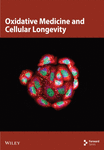Erratum to “The Role of Natural Products as Inhibitors of JAK/STAT Signaling Pathways in Glioblastoma Treatment”
H. Fahmideh, H. Shapourian, R. Moltafeti, et al., “The Role of Natural Products as Inhibitors of JAK/STAT Signaling Pathways in Glioblastoma Treatment,” Oxidative Medicine and Cellular Longevity 2022, no. 1 (2022):1–17, https://doi.org/10.1155/2022/7838583.
In the article titled “The Role of Natural Products as Inhibitors of JAK/STAT Signaling Pathways in Glioblastoma Treatment,” there was a spelling error in author Rasol Molatefi’s name in the author list, where Rasol Moltafeti should have read Rasol Molatefi.
Also, there was an error in Table 1. The chemical formula “C15H10O5” has been placed in the Cancer/cell type or animal model studied column instead of the Chemical formula column. The corrected table is shown below:
We apologize for this error.
| Natural compound | Type of natural compound | Chemical formula | Cancer/cell type or animal model studied | Used dosage | Function/Mechanism | Ref. |
|---|---|---|---|---|---|---|
| Polyphenols | Resveratrol | C14H12O3 | U251 cell line | 100 µM | Preventing STAT1 phosphorylation by inhibiting JAK and STAT3 and apoptotic genes induction | [5, 44, 45] |
| ROS generation and induce oxidation-related cellular lesions | ||||||
| LN18 and U87 cell lines | 20–40 µM | Reduction of epithelial to mesenchymal transition (EMT), expression of β-catenin and decreased the expression of stem cell markers (Twist, Snail, MMP-2, MMP-9, Slug, and Smad) | ||||
| Curcumin | C21H20O6 | Non-small cell lung cancer (NSCLC) | 1–20 µM | Improves drug resistance of gefitinib or erlotinib in cancer therapy | [46–51, 53−56, 126] | |
| Glioblastoma cells | 10–70 µM |
|
||||
| Bergamottin | C21H22O4 | Glioblastoma cells such as A549, U87 and U251 cell lines | 2 and 10 µM |
|
[5, 56, 59–62] | |
| Bavachin | C20H20O4 | Glioblastoma cells | 2 and 20 µM |
|
[5, 65, 66, 70] | |
| Microglia, macrophages, and chondrocytes | 0.5–10 µM |
|
||||
| Epigallocatechin Gallate (EGCG) | C22H18O11 | Glioblastoma cells | — |
|
[72–76] | |
| Cholangiocarcinoa (CCA) cells | 1–50 µM | Cells’ proliferation and migration impairing by STAT1 and STAT3 inactivation in administration of quercetin | ||||
| Colorectal carcinoma | 5 µM | Inhibiting the angiogenesis via the Janus kinase/STAT3/IL-8 pathway in administration of curcumin | ||||
| PDX mouse model | 50 mg/kg | |||||
| Glioblastoma cultures | 500 µM | Induction of autophagy and apoptosis | ||||
| Chalcones | C15H12O | Glioblastoma stem cells | 20–40 µM |
|
[77–80] | |
| Prostate cancer cells | 20 μg/mL | |||||
| Cardamonin | C16H14O4 | |||||
| Garcinol | C38H50O6 | Primary and recurrent glioblastoma cells | 2.5–40 µM | Decreasing STAT3 and STAT5A protein expression | [83, 84, 86] | |
| HCC cells | 10–25 µM | Inhibiting the STAT3 acetylation and dimerization, and negatively affects the protein’s ability to bind to DNA | ||||
| Pancreatic cancer cells (BxPC-3) | 10 and 25 µM | Targeting signaling molecules involved in apoptosis (X-IAP, cIAP, caspase-3, 9, PARP cleavage and NF-κB) | ||||
| Breast cancer cell lines MDA-MB-231 and Prostate cancer cell line DU145 | 10 and 25 µM | Decreasing both total and phosphorylated STAT3 | ||||
| U-87MG and GBM8401 cell lines | 2.5–40 µM |
|
||||
|
|
|||||
| Immunocompromised mice model | 1 mg/kg (Intraperitoneally) | Reducing glioblastoma tumor growth by attenuating STAT3/5A expression, enhancing the Bax/Bcl-xL apoptotic ratio, and downregulating the ki-67 proliferation index | ||||
| Silibinin | C25H22O10 | GMB cells and MCF-7 cell line | 100 µg/mL |
|
[10–12] | |
| Chrysin | C15H10O4 | Human umbilical vein endothelial cells (HUVECs) | 100 nM–100 µM |
|
[91–94] | |
| Glioblastoma cells (GBM8901 cells) | 25–100 µM | Arresting the cell cycle arrest in the G1 phase due to increasing P21 (waf1/cip1) and activating the P38-MAPK | ||||
| Apigenin | C15H10O5 | Glioblastoma cells (U1242 MG and U87 MG cell lines) | 10–80 µM |
|
[96–101] | |
| Rat C6 glioma cells | 1–100 µmol/L | Altering cytokine profiles, which are important for regulating the immune response | ||||
| Quercetin | C15H10O7 | Multiple cancer types such as Glioblastoma | Various concentrations such as 1.5–50 µM | Inducing the apoptosis and arresting phase G1 cell cycle in tumor cells, through its interaction with cell cycle regulators, including cyclin-dependent kinase (CDK)-4 and cyclin D1, activating p53, cytochrome c release, and also inducing caspase-9 and caspase-3 release | [103, 105–107, 127] | |
| T98G and U87 glioblastoma cell lines | 25 µM | Regulating the PI3K/Akt/mTOR signaling pathways, IL-6/STAT3 signaling pathways, modulation of apoptosis-related proteins, altering the intracellular pH (pHi), and MMP-2/-9 and fibronectin expression | ||||
| Glioblastoma mouse model | 20 mg/kg (oral gavage or injected intraperitoneally) | Sensitizes glioblastoma to t-AUCB by dual inhibition of Hsp27 and COX-2 | ||||
| Terpenoids | Cucurbitacins | C30H42O7 | T24 cell line | 250–2000 nM | Halting the G2/M phase of the cell cycle by activating caspases 8, 9, and 3 and inhibiting Fas/CD95 as well as STAT3/P53/P21 signaling (cucurbitacin E) | [112–115] |
| K562 cells | 5–80 nM | Inhibiting STAT3 activation and Raf/MEK/ERK signaling pathways (Cucurbitacin B) | ||||
| U87, U87-EGFR-WT and U87-EGFRviii glioblastoma cell lines | 25–5000 nmol/L | Inhibiting the. Proliferation of glioma cells by decreasing p-JAK1, p-JAK2, p-STAT3, and p-STAT5 and VEGF-induced JAK2 and STAT3 activation levels (Cucurbitacin I) | ||||
| U87MG cells | 100 nM | Inhibiting the HUVEC tubular formation | ||||
| Steroids | Diosgenin | C27H42O3 |
|
5–25 µM |
|
[123–125] |
| Dioscin | C45H72O16 | 25–100 µM | ||||




